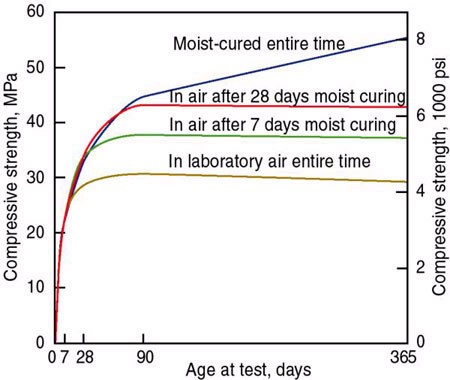🕑 Reading time: 1 minute
The minimum curing period for concrete is controlled by the type of cement used, ambient temperature, type of construction (size and shape of concrete member), designated strength, and curing regime.
For the majority of concrete structures, the minimum curing period at temperatures higher than 5°C is seven days or until the concrete strength reaches 70% of specified compressive or flexural strength, as per ACI 308.1R. It is possible to decline the curing period to three days if high-early strength concrete is used.
Moreover, according to IS-456, concrete curing should continue till it obtains 70% to 80% strength. The code also states that Ordinary Portland Cement needs to be cured for at least 7 days. The minimum curing period should be increased to 10 days if blended cement is used.
Contents:
What is the Minimum Curing Period for Concrete?
Concrete Curing Time Based on Cement Types
Table-1 shows the minimum curing period for concrete structures based on the type of cement used.
Table-1: Curing Time of Concrete Based on Types of Cement
| Types of Cement | Curing Time |
| Type I, ASTM C 150—For use when the special properties specified for any other type are not required. | 7 days |
| Type II, ASTM C 150—For general use, more especially when moderate sulfate resistance is desired. | 10 days |
| Type III, ASTM C 150—For use when high early strength is desired. | 3 days |
| Type IV, ASTM C 150—For use when a low heat of hydration is desired. | 14 days |
| Type V, ASTM C 150—For use when high sulfate resistance is desired. | 14 days |
| Hydraulic Cement, Blended Hydraulic Cements, Expansive Hydraulic Cement | Varies |
If concrete is placed at an average ambient temperature of 5°C or higher, the minimum curing period is as provided in Table-1 or the time during which the concrete gains 70% of its compressive or flexural strength, whichever is longer.
However, if testing of concrete is not carried out, the concrete should be kept above 10°C and cured for a period specified in Table-1. This is because the chemical reaction of concrete stops at around 7°C; concrete will no longer obtain strength.
When concrete is poured at an ambient temperature of less than 5°C, the concrete should be protected from the effects of freezing and thawing otherwise the durability of concrete is compromised. Sometimes, the durability requirement of concrete replaces the strength requirement while the curing period is determined.
One should be aware that, high temperature accelerates concrete strength development. However, the ultimate strength of concrete may be decreased. The temperature of water used for curing should be cooler than concrete by more than 11°C otherwise, it creates thermal shocks and leads to crack development.
Minimum Curing Time of Different Concrete Constructions
Table-2 shows minimum curing period for different concrete structures.
Table-2: Minimum Concrete Curing Period for Various Types of Construction
| Construction types | Examples | Curing period, days |
| Pavements and other slabs on ground | Highway pavements, airfield pavements, canal linings, parking lots, driveways, walkways, and floors | Refer to Table-1 |
| Buildings, bridges, and other structures | Cast-in-place walls, columns, slabs, beams, all other portions of buildings except slabs-on-grade, small footings, piers, retaining walls, tunnel linings, and conduits. | Refer to Table-1 |
| Unreinforced massive sections not containing ground granulated blastfurnace slag or pozzolan | - | 14 |
| Unreinforced massive sections containing ground granulated blastfurnace slag or pozzolan | - | 21 |
| Reinforced mass concrete | - | 7 |
| Colored concrete floors and slabs | - | 7 |
| Shrinkage-compensating concrete | - | 7 |
| Roller-compacted concrete | - | 14 |
| Shotcrete | - | 7 |
Table-3 illustrates how concrete gains compressive strength at 1, 3, 7, 14, and 28 days of curing.
Table-3: Concrete Compressive Strength Development Versus Curing Time
| Days | Compressive Strength |
| 1 Day | 16% |
| 3 Day | 40% |
| 7 Day | 65% |
| 14 Day | 90% |
| 28 Day | 99% |

FAQs
For the majority of structures, the curing time at temperatures above 5º C (40º F) should be at least 7 days or until 70% of the specified compressive or flexural strength is attained, whichever is longer. The curing period can be reduced to 3 days if high early strength concrete is used and the temperature is above 10º C (50º F). Additionally, the curing time needs to be increased if blended cement is used.
Curing of concrete begins as soon as the chemical reactions begin in concrete and it begins to harden concrete.
The addition of an accelerating agent like calcium chloride to the concrete mix before pouring would help concrete to harden quickly. Steam curing is one of the curing methods that can cure concrete fastly.
If normal cement is used, the concrete structure like foundations need at least 20 days to cure. However, high early strength cement concrete does not suffer from freezing and thawing require much lower duration to cure.
Read More
How to select right curing method for structural concrete elements?
how to speed up the curing process of concrete?
Casting and curing of concrete specimens in the field based on ASTM C31


